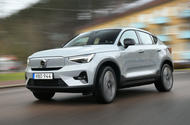Driven axle switch doesn’t transform driving experience but does make for a distinctly more compelling EV
Electrification is upending many traditions in the car industry, as this updated Volvo C40 Recharge demonstrates. It represents what once might have been termed a mid-life facelift, yet the styling is entirely unchanged.
Don’t be fooled, though: the face is one of the few things that Volvo hasn’t lifted. So comprehensive is the overhaul (or lifecycle update, as Volvo puts it) of the C40’s drivetrain that this Single version has had its motor switched from the front to the back axle, making it and the closely related XC40 Recharge (see right) the first rear-driven Volvos since the 940 saloon went out of production 25 years ago.
It’s a reflection of the relentless progress of EV technology and the ever-increasing competition in the class. Based on a multi-powertrain architecture, the C40 and XC40 siblings were lagging behind some other premium crossover EVs in key areas such as range, efficiency and charging speed. So Volvo has sought to address that using learnings from the bespoke EVs that it’s currently developing, such as the EX90.
For instance, the drive unit now on the rear axle of the C40 is the one on the front axle of the EX90. Combining a motor, a transmission and a ‘black box’, it has been fully developed in-house, whereas the previous one featured some off-the-shelf elements. And that greater integration has helped Volvo to improve efficiency.
The shift to rear-wheel-drive does give a small efficiency boostto the Single variants of the C40 and XC40, but it’s mostly for the benefit of the dual-motor, four-wheel-drive Twin versions (again, see right).
Elsewhere, the cars retain the same battery chemistry, although reworked cooling systems help keep that pack at its most efficient temperature, and allows for faster charging rates – although Single versions can accept a peak of only 130kW (as compared with 250kW for the Tesla Model Y or 350kW for the Genesis GV60, for instance).
Volvo has developed two versions of the Single powertrain, although only one – with a 235bhp motor and a 69kWh (67kWh usable) battery – will be offered in the UK. The late- pre-production model tested here features the other powertrain, with a 248bhp motor and an 82kWh (79kWh usable) battery. Volvo says it’s “representative” of the lesser-powered version, but clearly we will need to try a UK-spec car on our roads in order to offer a definitive verdict.
Unless you’re really up on your Volvo paint options, there’s nothing in terms of exterior or interior styling that would reveal the significant powertrain makeover of this model. Not that there’s any shame in that, as the C40 retains plenty of Scandi-cool appeal.
The muted colour palette isn’t the only aspect that’s very familiar: the powertrain switch doesn’t exactly transform the driving experience. In fact, if you didn’t know the shove was now coming from the rear wheels, you would be hard-pressed to tell. The steering is slightly sharper,
the balance when corneringis marginally improved and the front end is a little freer. But don’t expect thrilling steer-from-the- rear handling: the overriding driving impression remains one of Volvoness. Which is to say it’s pleasant, relaxing and smooth and will get you where you want to go comfortably and unobtrusively.
That might make you question why you would be so concerned with this ‘lifecycle update’. Ultimately, it comes back to the question of efficiency: the single-motor C40 now has an official efficiency of 3.7mpkWh, up from 3.5mpkWh. On the version that will come to the UK, that translates into a range of 297 miles, up from 272.
Those are official figures, of course, but they seemed achievable in reality: in our higher-powered test car, we averaged 3.7mpkWh on a relatively chilly day in Sweden. That’s enough to help the C40 close in on some rivals, such as the GV60 and the Audi Q4 E-tron Sportback, if not surpass them.
This, then, is perhaps the most comprehensive mid-life update to a car that you will barely notice – unless you’re an obsessive follower of EV efficiency statistics (guilty as charged).
Nevertheless, it’s a sensible move: Volvo hasn’t messed with any of the key strengths that might have tempted you to buy a C40 but has addressed some of the things that might have put you off. I would likely still forego a few miles of range for the more practical yet noticably cheaper XC40, though.
Source: Autocar
